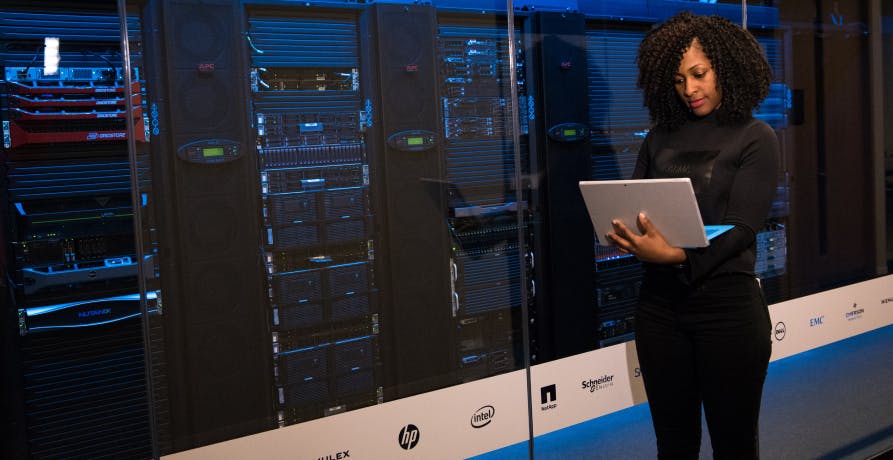What is Economic Sustainability?
What is Economic Sustainability, and why is it important in the midst of climate change?
Your request has been taken into account.
An email has just been sent to you with a link to download the resource :)

The intangible nature of the digital world means we tend to forget its growing impact on the environment – such as with Green IT.
Today, things are changing: awareness of the material aspect of digital technology is increasing, particularly with the recent fire at Maxnod's data center in Saint-Trivier-sur-Moignans in France – occuring in March 2023. In addition to this recent fire, OHV's data center in Strasbourg also brought awareness to the impact of Green IT.
The issue is now at the forefront of the political agenda, and for good reason: the consumption of digital technology accounts for nearly 4% of global emissions, and the sector's emissions are rising exponentially. This makes Green IT one of the most pivotal new areas to keep an eye on as the world begins to become more cognizant regarding climate change and how technology could either be our greatest enemy or asset in the fight to mitigate further global warming.
In this article, Greenly will explain the fundamental issues to help you understand the challenges of Responsible Digital Technology or Green IT, which provide a framework for addressing the environmental and social issues of the sector.
The notion of Green IT or Eco ICT (meaning Information and Communication Technologies) has been developed to provide solutions to the ecological and social footprint of digital technology. With the arrival of 5G data use and 8K displays, it’s time to take a closer look at what the concept of Green IT is really all about.
Green IT refers to all information technologies (ICT) whose use reduces the harmful effects of human activity on the environment.
However, this definition is incomplete. There are two complementary ways of defining the concept of Green IT, also known as “green computing”:
Are you confused by all the different names for Green IT? It’s understandable, as Green IT is reaching its first phase of maturity and there are more and more acronyms emerging, but don't worry – Greenly will explain everything to you.
However, the initial scope of Green IT 1.0 and 1.5 must be viewed with a certain objectivity.
It only aims to optimize the environmental footprint of digital technology itself. Especially since the creation of a multitude of green equipment and software could lead to over consumption, and, ultimately, to even more harmful effects on the environment.
This is the famous rebound effect. But what does that mean? The rebound effect means that the energy savings initially anticipated because of the arrival of a new technology, such as through Green IT, may be offset by the emergence of new behaviors and consumption patterns on a society-wide scale.
When it comes to Green IT, there is a risk that people will end up abusing use of said piece of technology – and ultimately not contribute to energy efficient targets. An example of this is someone who gets a new, high definition energy efficient television – but starts to watch T.V. more than usual since they are enjoying the new, crisper image.
Nonetheless, this initial scope is a solid start to changing our thinking in this field. The approach must simply be taken further with Green IT 2.0, the aim being to profoundly transform the way society functions in order to divide global GHG (Greenhouse Gas) emissions by 4 by 2050, and not only those caused by digital technology.
A final concept that should be discussed is Fair IT. This is the ultimate concept which completes those mentioned previously by being predominantly focused on the working conditions of employees in the digital sector.
Although Fair IT mainly concerns hardware and software suppliers, users are also major stakeholders in the process because they can influence these suppliers by requiring them to make ethical commitments.
For example, with FairComputer’s “High-Tech No Rights” campaign, during which the association, after carrying out major work on sourcing, asked the five largest suppliers to adopt a policy of social responsibility across their entire production chain.

It is estimated that the carbon footprint linked to digital activities accounts for around 4% of the world’s total emissions – which represents 2 gigatonnes of CO2.
How can digital activites and Green IT possibly amount to such a high figure? Digital technology emits a mass of carbon into the atmosphere equivalent to the weight of 200,000 Eiffel Towers. To sequester all this carbon would require covering 1/3 of the world's land surface with mature forests!
But where do these emissions come from?
According to a study by the Think Tank Green IT, digital emissions come from the extraction and processing of raw materials, the assembly of components, as well as transportation. Usage covers electricity consumption.
The other sources (end-of-life, sales service, etc.) are considered insignificant in terms of CO2. However, end of life is responsible for considerable pollution and has an impact on biodiversity which must be taken into account on another level.
Furthermore, the manufacture of digital devices has additional effects other than emitting CO2. In particular, the extraction of rare-earth elements for electronic components raises many concerns.
To better understand how much is emitted by digital technology, let’s look at the calculations in more detail.
There are two types of digital use:

The environmental impact of mobile devices and data centers is mainly caused by the manufacture and use of this equipment. The advantage is that data relating to the use of this equipment is easy to obtain: time of use, electricity consumption of the terminals, amount of computing equipment, etc.
Firstly, in terms of the “manufacture” part, it is easy to precisely measure your impact by taking into account each physical object, then breaking it down into sub-objects, and so on. This is the main purpose of the LCA methodology (“Life Cycle Analysis”). To estimate the ecological impact of a device, it is necessary to list the different emission sources for each component, by breaking them down into the fundamental building blocks: transportation, extraction of different raw materials, assembly, etc.
Therefore, it's important to remember that not all pieces of technology that qualify as Green IT will have the same environmental impact.
⚠️ However, don’t panic! You don't need to know which material makes up the SP-453 chip in your computer's hard drive. For example, the ecological impact of the sub-steps via which you obtain a computer, server or screen have been accurately calculated in numerous studies.
Furthermore, many free publications are produced each year detailing the LCAs of finished products. Calculators such as Greenly also use LCAs to measure the impact of manufacturing the equipment you use.
Secondly, there is the use of equipment and the electricity consumed. The consumption of your equipment can be calculated using its average electrical power supply and the time you spend using it. You can skip this step if you are conducting an overall carbon assessment of your activities, because the use of your devices is included in the electricity you pay for. All that remains to be done is to multiply the consumption by the carbon intensity of the electricity in the country where your business is located.
The carbon intensity of electricity is the number of kg of CO2 emitted for each kWh of energy generated. It will differ from country to country, depending on the share of renewable and nuclear power in the energy mix.
However, this measurement becomes more complicated if you are not using your own electricity – but other people's electricity. This is especially true of companies operating websites, or providing web services. For example, a visit to your website will consume electricity in two ways:
Cloud services, unlike physical servers, are virtual – and consumption is shared.
Therefore, a share of the emissions from the construction of equipment must be allocated according to each customer’s use.
In addition, the electricity consumption of Cloud services is broken down into two parts:
The consumption of equipment is estimated using the information provided by each supplier, such as the equipment used and pricing methods, in order to give an accurate overall picture of the consumption of each service.
Operators make every effort to reduce the structure's consumption by using economies of scale and state-of-the-art equipment (as a customer, always beware of greenwashing which has emerged so quickly). PUE, which stands for “Power Usage Effectiveness”, is the ratio between the total consumption of the data center and the electricity consumption of the IT equipment. This ratio is used to calculate the additional electricity consumption (cooling, lighting, etc.).
Most of the leading providers on the market directly publish their PUE, which can range from 1.1 to 2. Thus, selecting a data center with low PUE constitutes an important method of decarbonization for companies.
Moreover, the servers hosting Cloud services are often located far from the initial point of call. For example, Amazon Web Services, the Cloud service arm of Amazon, has the majority of its European servers based in Ireland. In addition to the carbon intensity of electricity, which can vary by a factor of 10 between two European Union countries, there is also the transporting of data, which can amount to significant volumes, thus representing a non-negligible share of network consumption.

You have accurately calculated the emissions from your servers and you are also aware of your biggest sources of emissions. Well done! The issue now is how to reduce these emissions associated with Green IT.
Here are some of our tips on how to avoid an environmental impact when using Green IT:
Given the importance of the manufacture of connected devices, the main way to reduce our emissions is to reduce the number of devices in circulation. This means extending the life of equipment, as well as not going overboard with connected gadgets. According to a Cisco study, in Western Europe, each person owns 8.9 connected devices on average!
If you count up the number of connected devices you own (work and personal computer, business phone, personal phone, connected speaker, smart watch, thermostats, cameras, printers, old phones), you will probably arrive at a similar figure.
Another way to extend the life of equipment is to buy refurbished devices from websites like Back Market or ReCommerce.
In addition to these options, Doji is a UK based platform where you can both buy refurbished devices as well as sell your old ones, too. Ultimately, companies like Doji are a great way to find the exact piece of technology you want while still keeping the environment in mind.
You could also repair your existing equipment. Devices such as the Fairphone are designed to be fully modular and, therefore, are easier to repair. As with household appliances, repairing your equipment rather than buying new products is one of the most eco-friendly solutions!
Furthermore, the responsibility of manufacturers cannot be ignored when talking about extending the life of products. For example, it would be better if the operating systems of phones and computers were maintained for longer, so as not to oblige consumers to buy new equipment because they are concerned about security or they are unable to use the latest applications.
Another way for companies to reduce their emissions is to switch to a Cloud service provider. The provider will use less energy to run its operations.
Suppliers such as AWS, Orange and Microsoft Azure can afford to invest human and financial resources in optimizing their overheads, which are heavily dependent on ancillary electricity consumption. Otherwise said, the ancillary consumption of AWS Data Centers is three times lower than that of a conventional on-site Data Center.
In addition, these Cloud service providers distribute the load in order to optimize processor consumption. Even processors consume less in a Cloud data center! Thanks to a so-called virtualization layer, many users can share the same machine, thus making better use of resources.
Other decarbonization measures can be taken, such as opting for high-performance processors, as not all processors consume the same amount of power per operation. You can also choose when to use your servers in order to take advantage of times when the carbon intensity of electricity in kgCO2/$ is at its lowest (mainly at night).
Your phone is from 2015, you’ve bought a refurbished computer, and your infrastructure is running on the best of the best Cloud servers – congratulations! Now, let’s see how you can take this a step further to reduce your environmental impact from digital technology and Green IT usage.
In this article, we have explained that digital emissions are caused by the manufacture of infrastructure, servers and terminals, as well as their electricity consumption. The challenge is therefore to limit the production and use of these machines to reduce their impact.
For servers and networks, there is a very simple solution.
We'll explain everything, but first, let’s go over a few technical elements.
Whether for the network or for data centers, sizing (i.e. the capacity of the infrastructure) is defined according to maximum demand, so that the service is never interrupted.
Therefore, the quantity of network equipment (antennas, cables, fiber) is sized according to the peaks in data consumption. As a result, taking measures to alleviate peaks in network use reduces the overall need for infrastructure, which generates CO2 emissions during its construction and use.
The same applies to renting computing power from data centers. Cloud providers make a certain number of processors available to their customers, enabling them to process calculations. To avoid service disruptions, the number of processors is defined according to peak demand. In the same way as for the network, taking action to “lighten the load”, by using computing capacity when it is most abundant, makes it possible to reduce the carbon impact of the Cloud service.
Next, you can relocate your Cloud to France. Vive la France! It's not just about being patriotic, French electricity is among the least carbon intensive in Europe. If all the AWS servers were moved to France, CO2 emissions linked to electricity would be divided by 6.5!
Finally, you can opt for digital sobriety. The best way to reduce your emissions is to reduce usage. So, remove unnecessary functions from your software and your overloaded pages. Go back to basics - opt for a low-tech philosophy. Because even if digital technology can be used to decarbonize certain sectors of the economy (video-conferencing instead of car travel, process optimization thanks to AI, etc.), we all need to move in the right direction and not increase our usage just for the sake of using digital technology!
Take our word of advice: opting to transition to the use of more sustainable Green IT and looking to reduce your energy consumption or other environmentally harmful practices with technology is one of the best ways to kick-start your sustainability journey.
If reading this article about Green IT has made you interested in reducing your carbon emissions to further fight against climate change – Greenly can help you!
For a deeper understanding of product impact, check out Life Cycle Analysis
Greenly can help you make an environmental change for the better, starting with a carbon footprint assessment to know how much carbon emissions your company produces.
Click here to learn more about Greenly and how we can help you reduce your carbon footprint.
Request a free and non-binding demo with one of our experts today and find the solution that best fits your business needs.


We review the green news once a month (or more if we find interesting things to tell you)